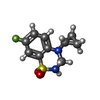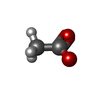[English] 日本語
 Yorodumi
Yorodumi- PDB-8bsu: Crystal structure of the kainate receptor GluK3-H523A ligand bind... -
+ Open data
Open data
- Basic information
Basic information
| Entry | Database: PDB / ID: 8bsu | ||||||
|---|---|---|---|---|---|---|---|
| Title | Crystal structure of the kainate receptor GluK3-H523A ligand binding domain in complex with kainate and the positive allosteric modulator BPAM344 at 2.9A resolution | ||||||
 Components Components | Glutamate receptor ionotropic, kainate 3 | ||||||
 Keywords Keywords | MEMBRANE PROTEIN / IONOTROPIC GLUTAMATE RECEPTOR / GLUK3 LIGAND-BINDING DOMAIN / GluK3-H523A-LBD / positive allosteric modulator / BPAM344 | ||||||
| Function / homology |  Function and homology information Function and homology informationPresynaptic function of Kainate receptors / cochlear hair cell ribbon synapse / adenylate cyclase inhibiting G protein-coupled glutamate receptor activity / kainate selective glutamate receptor complex / Activation of Ca-permeable Kainate Receptor / G protein-coupled glutamate receptor signaling pathway / glutamate receptor activity / negative regulation of synaptic transmission, glutamatergic / glutamate receptor signaling pathway / kainate selective glutamate receptor activity ...Presynaptic function of Kainate receptors / cochlear hair cell ribbon synapse / adenylate cyclase inhibiting G protein-coupled glutamate receptor activity / kainate selective glutamate receptor complex / Activation of Ca-permeable Kainate Receptor / G protein-coupled glutamate receptor signaling pathway / glutamate receptor activity / negative regulation of synaptic transmission, glutamatergic / glutamate receptor signaling pathway / kainate selective glutamate receptor activity / glutamate-gated receptor activity / glutamate-gated calcium ion channel activity / ligand-gated monoatomic ion channel activity involved in regulation of presynaptic membrane potential / dendrite cytoplasm / regulation of membrane potential / transmitter-gated monoatomic ion channel activity involved in regulation of postsynaptic membrane potential / synaptic transmission, glutamatergic / postsynaptic density membrane / modulation of chemical synaptic transmission / terminal bouton / presynaptic membrane / perikaryon / chemical synaptic transmission / postsynaptic membrane / axon / dendrite / glutamatergic synapse / plasma membrane Similarity search - Function | ||||||
| Biological species |  | ||||||
| Method |  X-RAY DIFFRACTION / X-RAY DIFFRACTION /  SYNCHROTRON / SYNCHROTRON /  MOLECULAR REPLACEMENT / Resolution: 2.9 Å MOLECULAR REPLACEMENT / Resolution: 2.9 Å | ||||||
 Authors Authors | Venskutonyte, R. / Frydenvang, K. / Kastrup, J.S. | ||||||
| Funding support | 1items
| ||||||
 Citation Citation |  Journal: FEBS J / Year: 2024 Journal: FEBS J / Year: 2024Title: Small-molecule positive allosteric modulation of homomeric kainate receptors GluK1-3: development of screening assays and insight into GluK3 structure. Authors: Yasmin Bay / Raminta Venskutonytė / Stine M Frantsen / Thor S Thorsen / Maria Musgaard / Karla Frydenvang / Pierre Francotte / Bernard Pirotte / Philip C Biggin / Anders S Kristensen / ...Authors: Yasmin Bay / Raminta Venskutonytė / Stine M Frantsen / Thor S Thorsen / Maria Musgaard / Karla Frydenvang / Pierre Francotte / Bernard Pirotte / Philip C Biggin / Anders S Kristensen / Thomas Boesen / Darryl S Pickering / Michael Gajhede / Jette S Kastrup /    Abstract: The kainate receptors GluK1-3 (glutamate receptor ionotropic, kainate receptors 1-3) belong to the family of ionotropic glutamate receptors and are essential for fast excitatory neurotransmission in ...The kainate receptors GluK1-3 (glutamate receptor ionotropic, kainate receptors 1-3) belong to the family of ionotropic glutamate receptors and are essential for fast excitatory neurotransmission in the brain, and are associated with neurological and psychiatric diseases. How these receptors can be modulated by small-molecule agents is not well understood, especially for GluK3. We show that the positive allosteric modulator BPAM344 can be used to establish robust calcium-sensitive fluorescence-based assays to test agonists, antagonists, and positive allosteric modulators of GluK1-3. The half-maximal effective concentration (EC) of BPAM344 for potentiating the response of 100 μm kainate was determined to be 26.3 μm for GluK1, 75.4 μm for GluK2, and 639 μm for GluK3. Domoate was found to be a potent agonist for GluK1 and GluK2, with an EC of 0.77 and 1.33 μm, respectively, upon co-application of 150 μm BPAM344. At GluK3, domoate acts as a very weak agonist or antagonist with a half-maximal inhibitory concentration (IC) of 14.5 μm, in presence of 500 μm BPAM344 and 100 μm kainate for competition binding. Using H523A-mutated GluK3, we determined the first dimeric structure of the ligand-binding domain by X-ray crystallography, allowing location of BPAM344, as well as zinc-, sodium-, and chloride-ion binding sites at the dimer interface. Molecular dynamics simulations support the stability of the ion sites as well as the involvement of Asp761, Asp790, and Glu797 in the binding of zinc ions. Using electron microscopy, we show that, in presence of glutamate and BPAM344, full-length GluK3 adopts a dimer-of-dimers arrangement. #1:  Journal: Febs J. / Year: 2024 Journal: Febs J. / Year: 2024Title: Small-molecule positive allosteric modulation of homomeric kainate receptors GluK1-3: development of screening assays and insight into GluK3 structure. Authors: Bay, Y. / Venskutonyte, R. / Frantsen, S.M. / Thorsen, T.S. / Musgaard, M. / Frydenvang, K. / Francotte, P. / Pirotte, B. / Biggin, P.C. / Kristensen, A.S. / Boesen, T. / Pickering, D.S. / ...Authors: Bay, Y. / Venskutonyte, R. / Frantsen, S.M. / Thorsen, T.S. / Musgaard, M. / Frydenvang, K. / Francotte, P. / Pirotte, B. / Biggin, P.C. / Kristensen, A.S. / Boesen, T. / Pickering, D.S. / Gajhede, M. / Kastrup, J.S. | ||||||
| History |
|
- Structure visualization
Structure visualization
| Structure viewer | Molecule:  Molmil Molmil Jmol/JSmol Jmol/JSmol |
|---|
- Downloads & links
Downloads & links
- Download
Download
| PDBx/mmCIF format |  8bsu.cif.gz 8bsu.cif.gz | 793.2 KB | Display |  PDBx/mmCIF format PDBx/mmCIF format |
|---|---|---|---|---|
| PDB format |  pdb8bsu.ent.gz pdb8bsu.ent.gz | 663.9 KB | Display |  PDB format PDB format |
| PDBx/mmJSON format |  8bsu.json.gz 8bsu.json.gz | Tree view |  PDBx/mmJSON format PDBx/mmJSON format | |
| Others |  Other downloads Other downloads |
-Validation report
| Summary document |  8bsu_validation.pdf.gz 8bsu_validation.pdf.gz | 5.2 MB | Display |  wwPDB validaton report wwPDB validaton report |
|---|---|---|---|---|
| Full document |  8bsu_full_validation.pdf.gz 8bsu_full_validation.pdf.gz | 5.3 MB | Display | |
| Data in XML |  8bsu_validation.xml.gz 8bsu_validation.xml.gz | 74.7 KB | Display | |
| Data in CIF |  8bsu_validation.cif.gz 8bsu_validation.cif.gz | 95.4 KB | Display | |
| Arichive directory |  https://data.pdbj.org/pub/pdb/validation_reports/bs/8bsu https://data.pdbj.org/pub/pdb/validation_reports/bs/8bsu ftp://data.pdbj.org/pub/pdb/validation_reports/bs/8bsu ftp://data.pdbj.org/pub/pdb/validation_reports/bs/8bsu | HTTPS FTP |
-Related structure data
| Related structure data |  8bstC C: citing same article ( |
|---|---|
| Similar structure data | Similarity search - Function & homology  F&H Search F&H Search |
- Links
Links
- Assembly
Assembly
| Deposited unit | 
| ||||||||
|---|---|---|---|---|---|---|---|---|---|
| 1 | 
| ||||||||
| 2 | 
| ||||||||
| 3 | 
| ||||||||
| 4 | 
| ||||||||
| Unit cell |
|
- Components
Components
-Protein , 1 types, 8 molecules ABCDEFGH
| #1: Protein | Mass: 29025.383 Da / Num. of mol.: 8 / Mutation: H523A Source method: isolated from a genetically manipulated source Details: THE PROTEIN CRYSTALLIZED IS THE EXTRACELLULAR LIGAND BINDING DOMAIN OF GLUK3-H523A. TRANSMEMBRANE REGIONS WERE GENETICALLY REMOVED AND REPLACED WITH A GLY-THR LINKER (RESIDUES 119 AND 120 OF ...Details: THE PROTEIN CRYSTALLIZED IS THE EXTRACELLULAR LIGAND BINDING DOMAIN OF GLUK3-H523A. TRANSMEMBRANE REGIONS WERE GENETICALLY REMOVED AND REPLACED WITH A GLY-THR LINKER (RESIDUES 119 AND 120 OF THE STRUCTURE). THEREFORE, THE SEQUENCE MATCHES DISCONTINUOUSLY WITH THE REFERENCE DATABASE (432-546, 669-806) Source: (gene. exp.)   |
|---|
-Non-polymers , 8 types, 197 molecules 














| #2: Chemical | ChemComp-2J9 / #3: Chemical | ChemComp-ZN / #4: Chemical | ChemComp-GOL / #5: Chemical | ChemComp-CL / #6: Chemical | ChemComp-SO4 / #7: Chemical | ChemComp-KAI / #8: Chemical | #9: Water | ChemComp-HOH / | |
|---|
-Details
| Has ligand of interest | Y |
|---|---|
| Has protein modification | Y |
-Experimental details
-Experiment
| Experiment | Method:  X-RAY DIFFRACTION / Number of used crystals: 1 X-RAY DIFFRACTION / Number of used crystals: 1 |
|---|
- Sample preparation
Sample preparation
| Crystal | Density Matthews: 2.32 Å3/Da / Density % sol: 47.01 % |
|---|---|
| Crystal grow | Temperature: 293 K / Method: vapor diffusion, hanging drop / pH: 8.5 Details: PEG 4000, lithium sulfate, zinc acetate, Tris buffer pH 8.5 |
-Data collection
| Diffraction | Mean temperature: 100 K / Serial crystal experiment: N |
|---|---|
| Diffraction source | Source:  SYNCHROTRON / Site: SYNCHROTRON / Site:  MAX II MAX II  / Beamline: I911-3 / Wavelength: 1 Å / Beamline: I911-3 / Wavelength: 1 Å |
| Detector | Type: MARMOSAIC 225 mm CCD / Detector: CCD / Date: Mar 29, 2015 |
| Radiation | Protocol: SINGLE WAVELENGTH / Monochromatic (M) / Laue (L): M / Scattering type: x-ray |
| Radiation wavelength | Wavelength: 1 Å / Relative weight: 1 |
| Reflection | Resolution: 2.9→46.84 Å / Num. obs: 47190 / % possible obs: 99.9 % / Redundancy: 4.1 % / Rpim(I) all: 0.066 / Rrim(I) all: 0.133 / Net I/σ(I): 11.6 / Num. measured all: 192159 |
| Reflection shell | Resolution: 2.9→3.06 Å / % possible obs: 99.7 % / Redundancy: 4.1 % / Num. measured all: 27910 / Num. unique obs: 6808 / Rpim(I) all: 0.245 / Rrim(I) all: 0.498 / Net I/σ(I) obs: 3.5 |
- Processing
Processing
| Software |
| |||||||||||||||||||||||||||||||||||||||||||||||||||||||||||||||||||||||||||||||||||||||||||||||||||||||||||||||||||||||||||||||||||||||||||||||||||||||||||||||||||||||||||||||||||||||||||||||||||||||||||||||||||||||||||||||||
|---|---|---|---|---|---|---|---|---|---|---|---|---|---|---|---|---|---|---|---|---|---|---|---|---|---|---|---|---|---|---|---|---|---|---|---|---|---|---|---|---|---|---|---|---|---|---|---|---|---|---|---|---|---|---|---|---|---|---|---|---|---|---|---|---|---|---|---|---|---|---|---|---|---|---|---|---|---|---|---|---|---|---|---|---|---|---|---|---|---|---|---|---|---|---|---|---|---|---|---|---|---|---|---|---|---|---|---|---|---|---|---|---|---|---|---|---|---|---|---|---|---|---|---|---|---|---|---|---|---|---|---|---|---|---|---|---|---|---|---|---|---|---|---|---|---|---|---|---|---|---|---|---|---|---|---|---|---|---|---|---|---|---|---|---|---|---|---|---|---|---|---|---|---|---|---|---|---|---|---|---|---|---|---|---|---|---|---|---|---|---|---|---|---|---|---|---|---|---|---|---|---|---|---|---|---|---|---|---|---|---|---|---|---|---|---|---|---|---|---|---|---|---|---|---|---|---|
| Refinement | Method to determine structure:  MOLECULAR REPLACEMENT / Resolution: 2.9→45.33 Å / SU ML: 0.37 / Cross valid method: THROUGHOUT / σ(F): 1.36 / Phase error: 23.99 / Stereochemistry target values: ML MOLECULAR REPLACEMENT / Resolution: 2.9→45.33 Å / SU ML: 0.37 / Cross valid method: THROUGHOUT / σ(F): 1.36 / Phase error: 23.99 / Stereochemistry target values: ML
| |||||||||||||||||||||||||||||||||||||||||||||||||||||||||||||||||||||||||||||||||||||||||||||||||||||||||||||||||||||||||||||||||||||||||||||||||||||||||||||||||||||||||||||||||||||||||||||||||||||||||||||||||||||||||||||||||
| Solvent computation | Shrinkage radii: 0.9 Å / VDW probe radii: 1.11 Å / Solvent model: FLAT BULK SOLVENT MODEL | |||||||||||||||||||||||||||||||||||||||||||||||||||||||||||||||||||||||||||||||||||||||||||||||||||||||||||||||||||||||||||||||||||||||||||||||||||||||||||||||||||||||||||||||||||||||||||||||||||||||||||||||||||||||||||||||||
| Refinement step | Cycle: LAST / Resolution: 2.9→45.33 Å
| |||||||||||||||||||||||||||||||||||||||||||||||||||||||||||||||||||||||||||||||||||||||||||||||||||||||||||||||||||||||||||||||||||||||||||||||||||||||||||||||||||||||||||||||||||||||||||||||||||||||||||||||||||||||||||||||||
| Refine LS restraints |
| |||||||||||||||||||||||||||||||||||||||||||||||||||||||||||||||||||||||||||||||||||||||||||||||||||||||||||||||||||||||||||||||||||||||||||||||||||||||||||||||||||||||||||||||||||||||||||||||||||||||||||||||||||||||||||||||||
| LS refinement shell |
| |||||||||||||||||||||||||||||||||||||||||||||||||||||||||||||||||||||||||||||||||||||||||||||||||||||||||||||||||||||||||||||||||||||||||||||||||||||||||||||||||||||||||||||||||||||||||||||||||||||||||||||||||||||||||||||||||
| Refinement TLS params. | Method: refined / Refine-ID: X-RAY DIFFRACTION
| |||||||||||||||||||||||||||||||||||||||||||||||||||||||||||||||||||||||||||||||||||||||||||||||||||||||||||||||||||||||||||||||||||||||||||||||||||||||||||||||||||||||||||||||||||||||||||||||||||||||||||||||||||||||||||||||||
| Refinement TLS group |
|
 Movie
Movie Controller
Controller




 PDBj
PDBj








